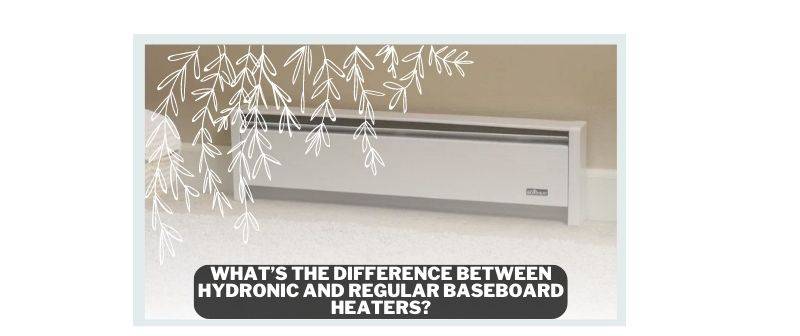Most people start planning for heating types of equipment even before the arrival of the winter season.
The most popular heating types of equipment are hydronic baseboard heaters and electric baseboard heaters because they go a long way in the reliability and redundancy of front
While there are several options for these heating types of equipment in the market, it doesn’t matter much if the BTUs come from an electric heater that heats the air directly by radiation or one that heats a liquid directly by convection.
The same amount of BTU is required to keep the room at the same temperature.
However, there is some merit to the use of hydronic heaters over regular baseboard heaters. In this post, we are going to break down for you several notable differences between hydronic baseboard heaters and regular baseboard heaters.
The Differences between Hydronic Baseboard Heaters and Regular Baseboard Heaters

Hydronic baseboard heaters are ceramic heaters that are very energy efficient and quite safe too because the casing of the heater remains cool even while being used.
They are best fitted for heating small rooms because it takes quite some time for them to heat up and the heat produced cannot be controlled as regular baseboard heaters. Once they are set, they can produce a great amount of heat compared to their size.
Regular baseboard heaters, on the other hand, are electric baseboard heaters that use zonal heating to warm your home.
Zonal heating is the new process of warming the room or space that you and your family use the most instead of heating the entire house.
In zonal heating, you divide the home into separate zones depending on the regular usage and temperature requirement of each zone.
Through efficient convection technology, the air is circulated throughout the room warming it naturally.
Electric baseboard heaters come in different voltages, lengths, colors with thermostats, corners, and blank pieces to accommodate any space.
The merits of electric individual zones are that your entire system is very unlikely to fail all at once which is not so with hydronic baseboard heaters.
The complexity of hydronic heaters makes it hard for repairs in case the system breaks down.
You might find that your baseboard heater has experienced pump failure. There are a variety of pumps within the system; therefore the likelihood of 1 of them eventually failing is great.
On the other hand, electric heaters are very heavily energy-dependent. They gobble up energy much more than hydronic baseboard heaters.
Though hydronic baseboard heaters have reheating lag time, they tend to continue emitting heating longer than electric baseboard heaters.
A Hydronic baseboard heater through a macro-scale large thermal mass regulates the temperature swings and holds heat.
The baseboard heater only attempts to maintain the temperature where it is located whether on the unit (portable or hardwired) or the wall (hard wired only).
With electric baseboard heaters, a slower temperature swing (thermal inertia) may vary more slowly or less often but may not vary less in temp swing unless the t-stat has a smaller on-off offset.
Electric baseboard heaters use convection to warm up the room. Direct air heating seems to make the air less humid faster for some reason.
A house with a regular baseboard heater will be less humid than the same house that has a water heater. It’s quite noticeable. To deal with this issue Install a humidifier and all is moot.
On the other hand hydronic baseboard heaters warm through radiation just like the sun and use natural airflow to evenly spread heat across the room.
With hydronic baseboard heaters, there is no simple way to install central air conditioning systems, air filtering systems, or whole house humidifiers.
The quality of workmanship on hydronic and electric baseboard heaters is also quite interesting. The ceramics make these units very energy efficient and are also quite safe too because the casing of the heaters remains cool even while being used.
This makes them a great option if you have pets and kids.
Hydronic Baseboard Heating Problems and Their Solutions
Many homes use baseboard heaters for heating purposes. They can be efficient to operate though they might experience problems.
While this does not happen regularly, there is a high likelihood of some components in the system failing. Some of it is that you might find your baseboard radiator heat system difficult to maintain and operate.
In this post, we are going to break down for you a couple of hydronic baseboard heater system problems and their solutions.
A hydronic baseboard system consists of a network of pipes and many components. So, how would you know which component has developed a problem?

When the system fails, it is usually not the whole system. Normally the bearings in the system fail and you might begin hearing noises.
So if your system starts making lots of noise the first troubleshooting is to check the bearings to check if they are beginning to fail and need replacement.
Replacement is usually a fairly simple task since most systems have an isolation valve which makes it easy to be replaced with little loss of liquid from the system.
Another relatively simple problem in the system is that they could develop leaks. This is not common, but it is a possibility. If this occurs you need to reseal the whenever you notice leaks.
Another possible problem with your baseboard radiator heat system could be a failure to emit sufficient heat. This is linked to the heater element in the tube.
The likelihood of this happening is slim. This is attributed to the design of the baseboard heater which is enclosed.
Water heaters fail much more often, but in a hydronic baseboard radiator system, the water is generally enclosed and is not replenished regularly, therefore, there is not a significant build-up of calcium in the tank as there is in your hot water tank.
That calcium that your system brings in will settle in the bottom of a water heater and causes hot spots and eventual failure of the water tank. This is not usually the case with the baseboard radiator heating system’s tank.
So in case the heaters are not emitting sufficient heat adjust the heater’s thermostat. Hydronic baseboard heaters emit heat in response to a thermostat, whether it’s half of the actual heater or linked to the heater during the installation process.
The system requires 240v to sufficiently heat the system. A thermostat that is set too low will trigger the heater to decrease its warmth output.
Also, the radiator units in the baseboard radiator systems are typically made up of copper tubes with fine sheet metal fins attached.
The heater’s proximity to the floor makes it prime for accumulating all types of debris and mud. These fins get clogged by dust which can clog the heater’s vents and heating grill and limit heat production.
The only way to take care of the problem is to clean the tubes with a vacuum cleaner. Turn off the heater and allow it to chill, and then use a vacuum or gentle brush to take away any dust and debris.
Check also that the heater is plugged into an influence source in the event you feel no warmth emanating from the device.
Some units are designed to be self-put in and simply hook up with an ordinary outlet. Others are wired directly into the home’s electrical system and it’s essential to seek the advice of a licensed electrician.
Another problem you might incur, and often comes as a result of decorating is leaking in the system.
Sometimes when people decorate they nail or screw things into the walls, and if the contractor did not protect your system well, you may puncture some of the pipes.
Examine the carpeting across the baseboard heater. If you leak into your system it is normally obvious because you will see wet floors or carpets underneath the baseboard units.
The way to go around this problem is to call in a plumber to replace the piping system.
Relying on the heater’s specific design, the carpet may be blocking the vents that are dispensing warmed air.
Cutting the carpet to fit the heaters, raising the heater from the floor, or putting in a carpet with a shorter pile might resolve this problem.
Conclusion
I would recommend hydronic baseboard heaters to baseboard electric because they are quiet and are low energy heaters that are energy efficient and a great heating solution for your home.
By using them wisely you can heat up your home properly without having to spend much money on your electricity bill. To keep things simple learn more about hydronic baseboard heaters.
We will enable you to select the right model and save money on your energy bills this winter
Related post:
- 27 Cozy Dark Bedroom Inspiration Ideas for Warm and Relaxing - July 13, 2025
- Which Robot Lawn Mower Is Right for You? A Comparison of 6 Common Types - July 12, 2025
- 25 Neutral Boho Bedroom Inspiration Cozy, Calm & Beautiful - July 12, 2025

